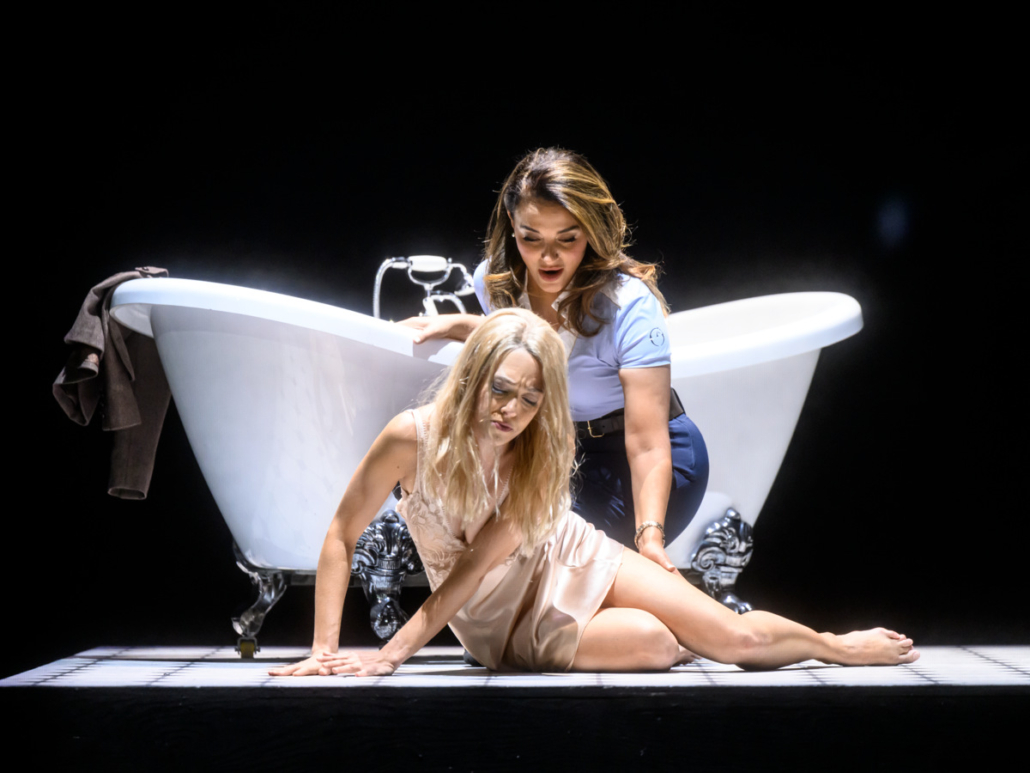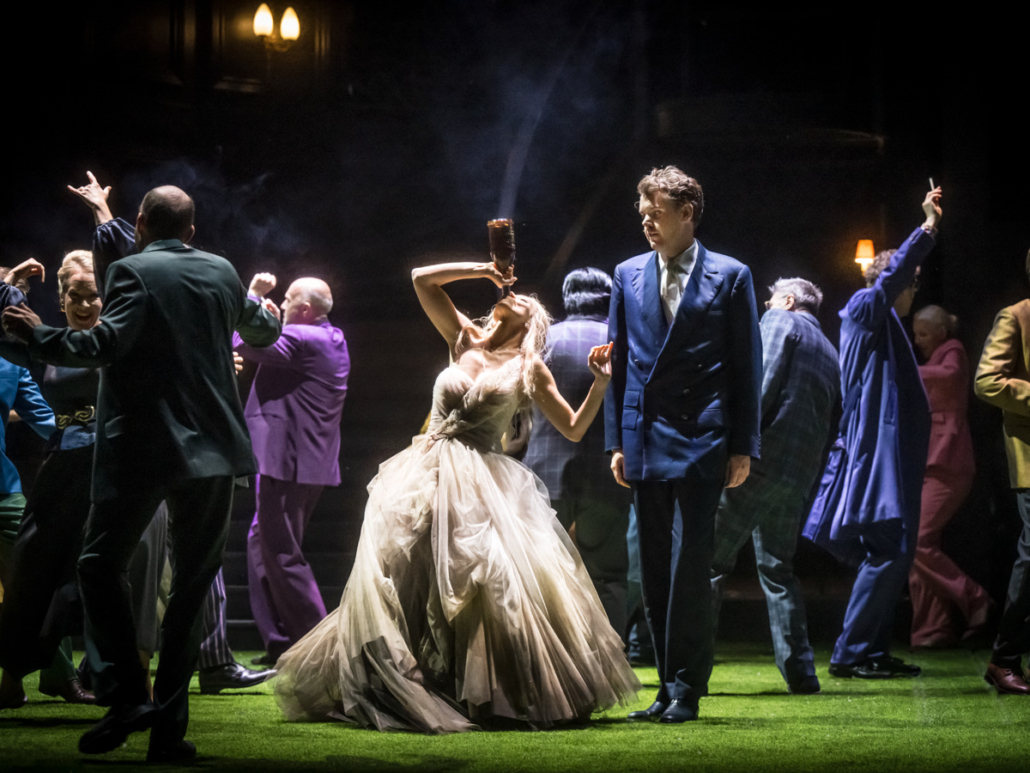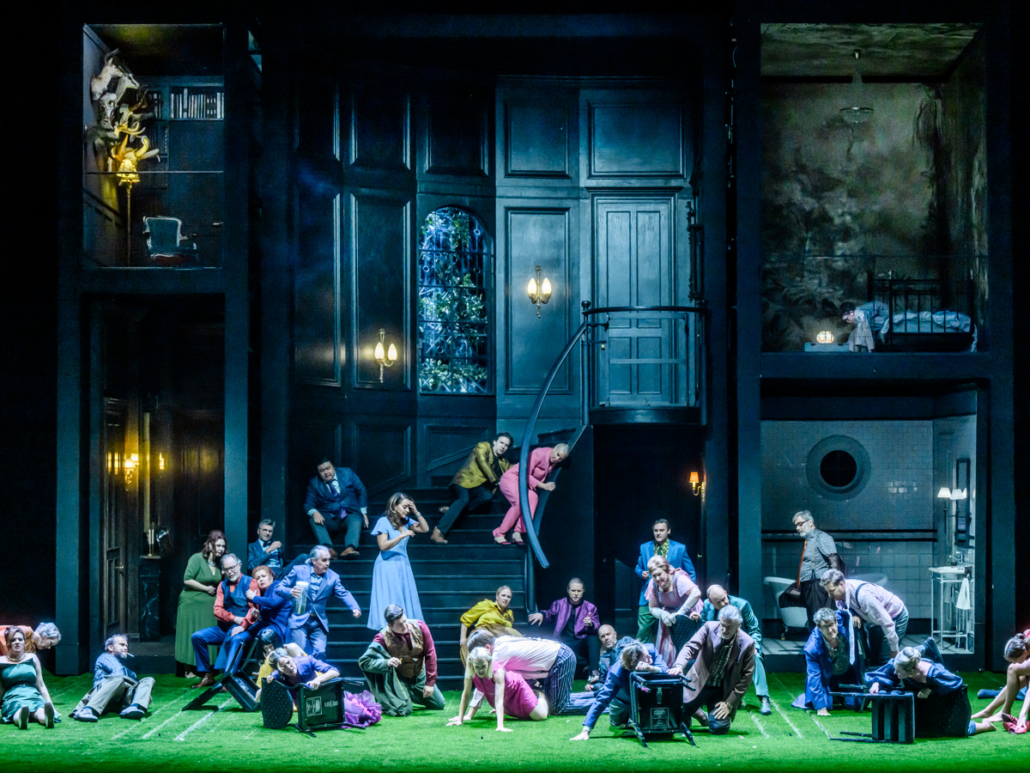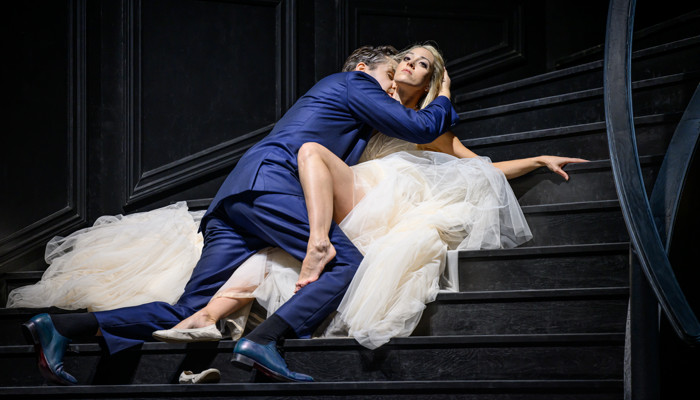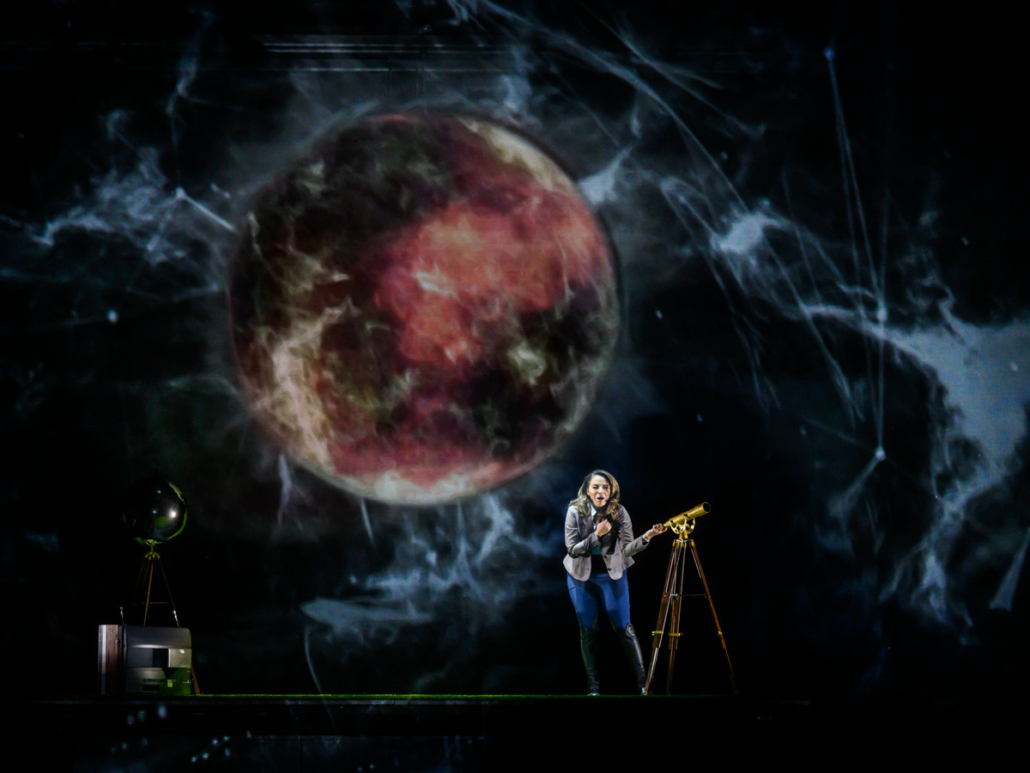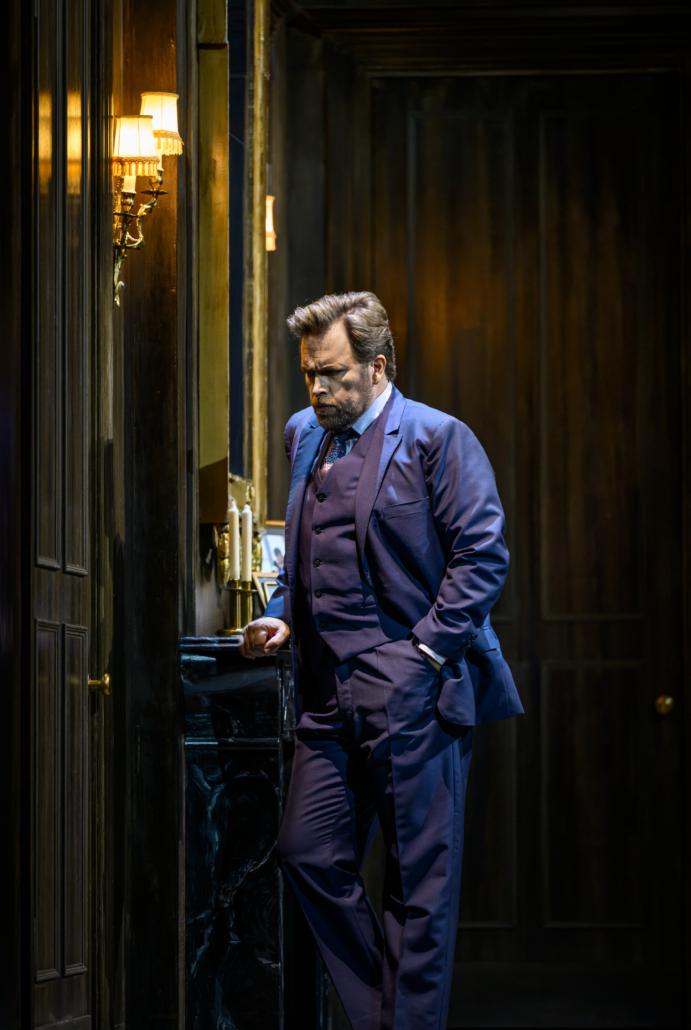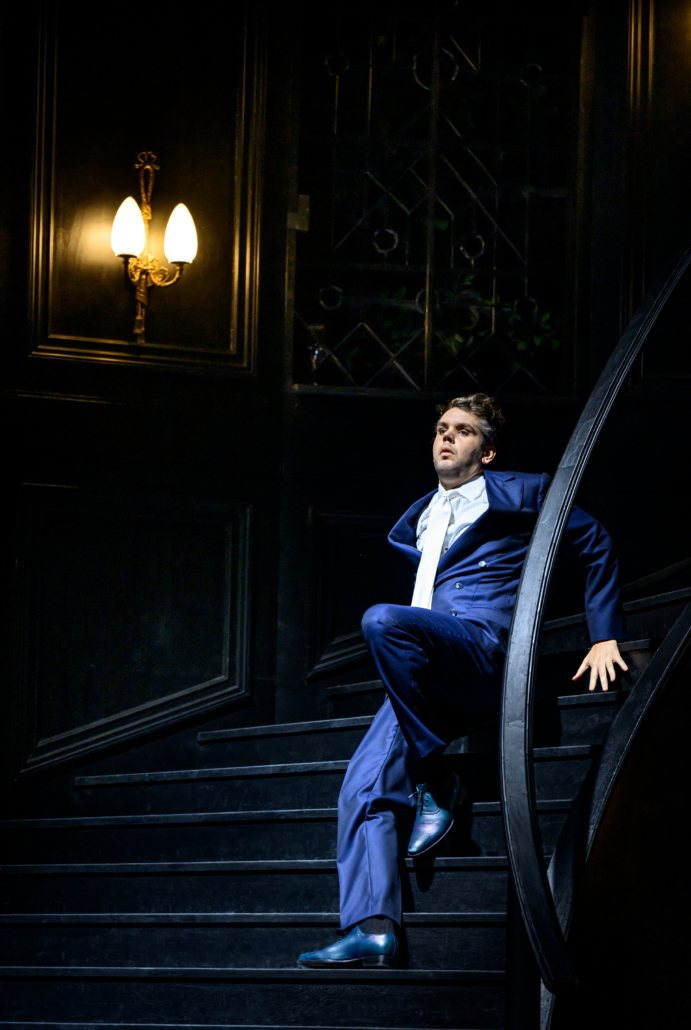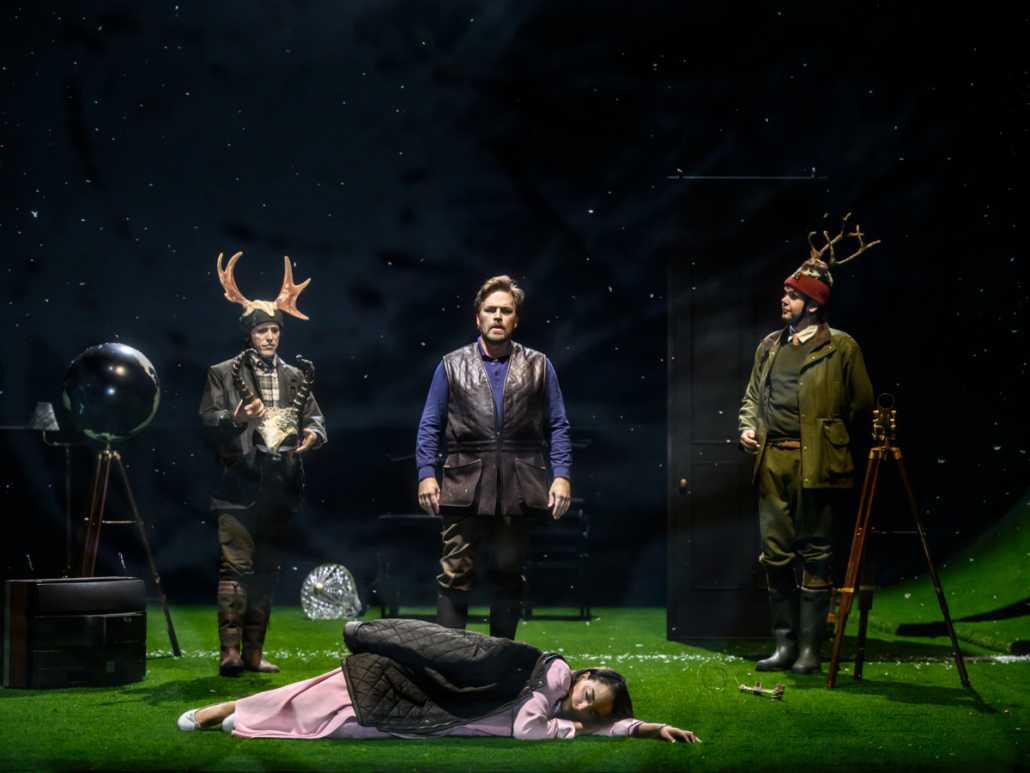Melancholia is a grand opera in two acts, adapted from the film by Lars von Trier by Mikael Karlsson and Royce Vavrek.
At her wedding reception, the beautiful but depressed Justine spots a red star in the sky. It is the planet Melancholia, which is on a collision course with Earth. The bridegroom Michael tries to calm her down with his love, her mother Gaby poisons her with her darkness, and her sister Claire attempts to rescue her with her solicitude. But no-one can stop the mysterious forces ignited within Justine. And Melancholia gets closer and closer…
The iconic director Lars von Trier’s apocalyptic Melancholia took the world by storm in 2011. The composer Mikael Karlsson – known to the Royal Swedish Opera’s audiences for his music to Alexander Ekman ballets such as Midsummer Night’s Dream and Escapist – has now made a full-length opera based on the fascinating film. The librettist is Royce Vavrek, who also wrote the libretto for the operatic version of von Trier’s Breaking the Waves. The soloists include the soprano Lauren Snouffer – a virtuoso performer of both baroque opera and contemporary music – as Justine, Metropolitan Opera’s young rising star Rihab Chaieb as Claire, and Anne Sofie von Otter as the ice-cold mother Gaby.
(from the Royal Swedish Opera website)
A rogue planet hurls towards earth, unbeknownst to humankind.
ACT 1
At her wedding reception at an extravagant golf resort, a young bride named Justine has married her groom Michael. They are late to the reception where Justine’s sister Claire is waiting for them, as Justine wants to introduce her husband to her beloved horse Abraham, kept in the stable. Her sister Claire finds them and chastises them for their tardiness, forcing them to join their waiting guests. At the festivities speeches are made, including an acid-tongued diatribe by Justine’s mother Gaby, and another by Jack, her father-in-law, and also employer, who has been chasing her around looking for a tagline for a work-related promotional campaign.
Throughout the reception Justine becomes more and more disconnected, seized by a bout of depression – a “gray wooly yarn” that envelopes her. She excuses herself from the celebration and finds herself in a bathtub with her mother, who goes off about the empty rituals of marriage. Justine is surprised by Michael, who privately gives Justine a wedding gift: an orchard of apples. It is Michael’s hope that the serenity of the orchard might be welcome for Justine’s unsound mind. She cannot muster much interest in the apples and rejoins the party.
When Tim, a young male employee at her father-in-law’s agency, attempts to extract a tagline on behalf of Jack, Justine instead takes him to a golf green and they have primal intercourse, which Michael is witness to. Justine returns to a food truck serving a midnight meal where she curses out Jack, and expresses her supreme displeasure working for him, effectively refusing an offer of promotion, and terminating her position. Soon, all of the guests depart, leaving only Justine and Claire as well as Claire’s husband John and son Leo. Leo has news of a planet – Melancholia – that is on a warpath with Earth, but should narrowly miss direct collision.
ACT 2
The next morning after a horseback ride, Claire and Justine experiment with a new contraption, a measuring device made by John that is meant to track the distant planet. Jack assures Claire that the planet isn’t getting any larger. Shortly thereafter, Justine’s depression flares, as Claire helps her get into the bathtub, her body unable to step into the porcelain. Then a moment of surrealism, as Justine becomes Ophelia, floating in the water, her sadness taking on Shakespearian dimensions.
Armed with his measuring contraption, we witness Jack understand the reality that the planet is indeed rocketing towards earth at an alarming speed. Jack, no longer able to protect his family, commits suicide in Abraham’s stable. Claire finds her husband’s dead body, covering it with hay, and condemns his cowardly final choice. She then finds Justine and begs her for a moment of sisterly connection as the end draws near. Justine has no desire for such pleasantries, instead choosing to share empathy with her nephew Leo, as the two of them making a magic cave to share when Melancholia strikes.
MUSIC Mikael Karlsson
LIBRETTO Royce Vavrek
Based on the film by Lars von Trier
ORCHESTRATION Michael P. Atkinson & Mikael Karlsson
CONDUCTOR Andrea Molino
DIRECTOR Sláva Daubnerová
SET DESIGN Boris Kudlicka
COSTUME DESIGN Chrisi Karvonides-Dushenko
LIGHT DESIGN Tom Visser
SOUND DESIGN Avgoustos Psillas
VIDEO Bartek Macias
DRAMATURGE Katarina Aronsson
CHOREOGRAPHY Charlotta Öfverholm
COMMISSIONED AND PRODUCED BY The Royal Swedish Opera and Birgitta Svendén.
WORLD PREMIERE OCTOBER 21 2023.
WITH KIND PERMISSION FROM Zentropa Entertainments
RUNNING TIME Approx. 2 hours 30 minutes.
WORLD PREMIERE CAST
Royal Swedish Opera Oct 21 – Nov 4 2023
Justine: Lauren Snouffer
Claire: Rihab Chaieb
Gaby: Anne Sofie von Otter
John: Ola Eliasson
Michael: Jens Persson Hertzman
Jack: Johan Edholm
Tim: Mikael Stenbaek
Leo: Anton Textorius / Nils Chin Nygårds
Bean counting man: Klas Hedlund
“The coolest opera in a very long time.”… “Visually rich, beautiful, and musically exciting without sounding ‘difficult'” – Gunilla Brodrej, Expressen.
“Melancholia, the opera, goes for a knock-out but ends up making me more exhilarated than struck down.”… “Composer Mikael Karlsson’s and librettist Royce Vavrek’s full evening opera is the crowning achievement of the National Opera Stage 250 year anniversary celebration, and even though they have adapted a popular film, this is no cautious venture.” – Jacob Lundström, Dagens Nyheter
– Gunilla Brodrej, Expressen
– Jacob Lundström, Dagens Nyheter
“This offering really touched and moved me. I was immersed in this universe. Exciting, rich and unpolished thanks to the use of various techniques. [Karlsson] knows how to punctuate and ritualize his writing with sound and acoustic effects. In short a successful adaptation. The piece evokes the film very well.”
– Charles Arden, Radio France
“Karlsson’s score deserves much praise. He understands the “new” language of contemporary opera that maintains tonal underpinnings but stretches tonal boundaries. The music has the kind of dissonance borne of our exposure to contemporary cinema in which musical scores have done a magnificent job of tuning our ears to new classical idioms. The dissolution of Justine’s marriage includes familiar ground bass treatments with bluesy ostinato modulations. While the vocal lines can be disjointed, at no point does Karlsson’s score seem off-putting. There were many memorable passages, and I’d hope with some cuts, this work might rank as one of the most interesting operas of this quarter-century.”
– Edward Klingspor, SvD
– Claes Wahlin, Aftonbladet
Camilla Lundberg on National Swedish Television
Melancholia was on the top lists of “best 5 shows in October” in both Svenska Dagbladet and Dagens Nyheter”.
Justine (20s – 30s) – Soprano
Claire (20s – 30s) – Mezzo soprano
Gaby (50s – 60s) – Mezzo soprano
Michael (20s – 30s) – Baritone
John (30s – 40s) – Bass baritone
Jack (40s – 60s) – Baritone
Leo (child) – Boy Soprano
Tim (20s – 40s ) – Tenor
Bean Counting Man (30s – 60s) – Tenor
Full Chorus (on stage in act 1, off-stage in act 2)
Instrumentation
2 Flutes (I = Bass Flute, II = Alto Flute, Piccolo)
2 Oboes (II = English Horn)
2 Clarinets in Bb (II = Bass Clarinet in Bb)
2 Bassoons (II = Contrabassoon)
4 Horns in F
2 Trumpets in C (I, II = Flugelhorn in Bb)
2 Tenor trombones
Bass Trombone
Tuba
Timpani
Percussion (3 players)
Sampling Keyboard
Harp
Chorus (SATB)
Soloists
Strings (C extensions for Contrabasses)
The score utilizes a pre-recorded backing track synchronized to a click track, which is triggered by the Sampling Keyboard player. An appropriate headset is required for the conductor to hear click track playback.
All singers, the chorus and the orchestra are amplified.
The purpose of the amplification is to allow for less belting in singing, and to be able to mix electronics in a good way with the acoustic instruments. The amplified sound is mixed with backing tracks (some scenes only), live synths and samples. The conductor and the percussionists have headphones for click and playback. No one else does. The mix into the auditorium is multichannel. For the premiere production we used
1-2 Proscenium speakers
3-4 Side speakers
5-6 Rear speakers
7-8 High, surround speakers (directed at balconies)
9 Sub bass
10 Floor speakers / shakers
11 Chandelier speaker.
It’s mostly the backing tracks (for some scenes) and the sample synth that use the surround field speakers. There is a center speaker system on the edge of the stage that is only for the singers’ amplification.
The synth player uses an 88 key electric piano with weighted keys that triggers synths through Ableton Live.
The Ableton project requires an Ableton Live license, and the following software synths:
U-He Diva, U-He Zebra 2, Arturia Pigments, Korg Opsix Native
We use Relab Development LX480 Dual Engine Reverb for its Lexicon reverb emulations.
The synth player steps through 24 “Ableton scenes” to have the synth automatically change the synths and sample synths through the score. One octave is always saved for composed multi-channel samples, composed by Mika. All software is usually 50% off during Black Friday sales each year. That’s a good time for the house to acquire the needed software and licenses.
The synth player also triggers backing tracks for the scenes that use them. This is done on a separate system that runs Qlab. The Qlab project plays the pre-mixed backing tracks and a click track for the conductor and percussionists to guide the orchestra to synchronize with the prerecorded audio. Qlab requires a license.
All this amounts to a surround sound experience with live and prerecorded audio running with the acoustic performance, in perfect sync, and performed on a synth as a regular instrument. A vast sound world is thereby achieved, along with a more powerful listening field (especially for the orchestra seats).
Mika needs ample, dedicated mixing time in the auditorium to create a custom mix of the music. Almost no house has a predictable audio system, so a dedicated mix for the house is necessary.
The programming is best handled by Jocki Lövmark, who created the initial Ableton session.

